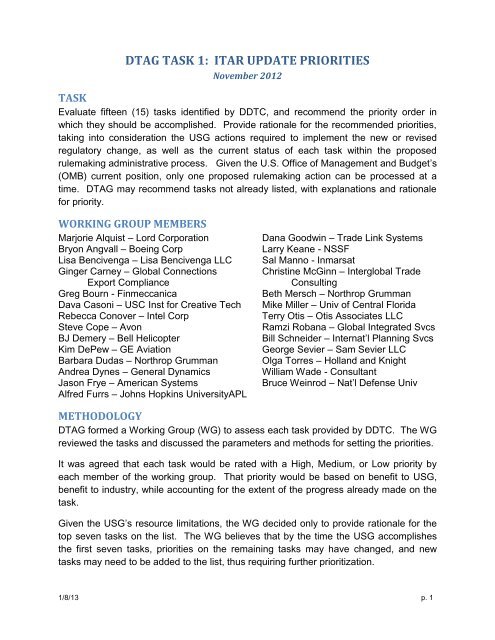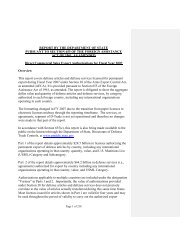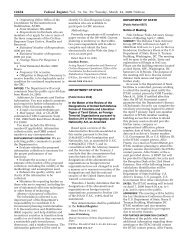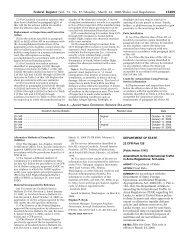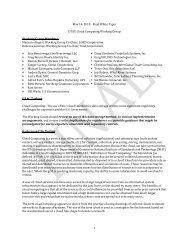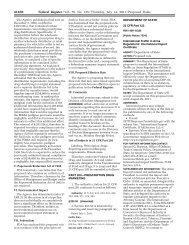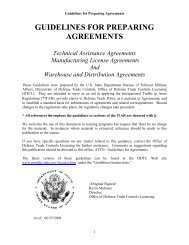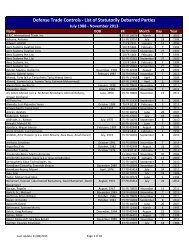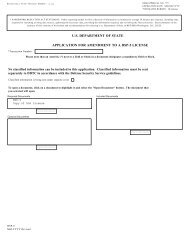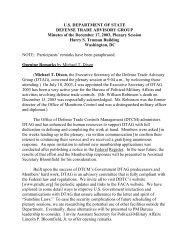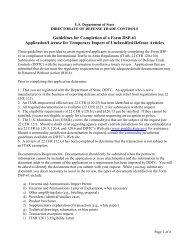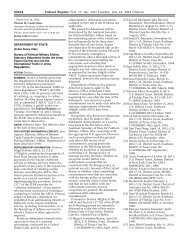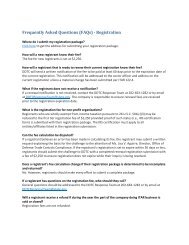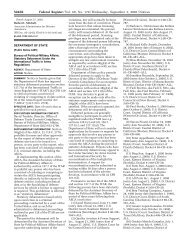dtag task 1 - Directorate of Defense Trade Controls
dtag task 1 - Directorate of Defense Trade Controls
dtag task 1 - Directorate of Defense Trade Controls
You also want an ePaper? Increase the reach of your titles
YUMPU automatically turns print PDFs into web optimized ePapers that Google loves.
DTAG TASK 1: ITAR UPDATE PRIORITIES<br />
November 2012<br />
TASK<br />
Evaluate fifteen (15) <strong>task</strong>s identified by DDTC, and recommend the priority order in<br />
which they should be accomplished. Provide rationale for the recommended priorities,<br />
taking into consideration the USG actions required to implement the new or revised<br />
regulatory change, as well as the current status <strong>of</strong> each <strong>task</strong> within the proposed<br />
rulemaking administrative process. Given the U.S. Office <strong>of</strong> Management and Budget’s<br />
(OMB) current position, only one proposed rulemaking action can be processed at a<br />
time. DTAG may recommend <strong>task</strong>s not already listed, with explanations and rationale<br />
for priority.<br />
WORKING GROUP MEMBERS<br />
Marjorie Alquist – Lord Corporation<br />
Bryon Angvall – Boeing Corp<br />
Lisa Bencivenga – Lisa Bencivenga LLC<br />
Ginger Carney – Global Connections<br />
Export Compliance<br />
Greg Bourn - Finmeccanica<br />
Dava Casoni – USC Inst for Creative Tech<br />
Rebecca Conover – Intel Corp<br />
Steve Cope – Avon<br />
BJ Demery – Bell Helicopter<br />
Kim DePew – GE Aviation<br />
Barbara Dudas – Northrop Grumman<br />
Andrea Dynes – General Dynamics<br />
Jason Frye – American Systems<br />
Alfred Furrs – Johns Hopkins UniversityAPL<br />
Dana Goodwin – <strong>Trade</strong> Link Systems<br />
Larry Keane - NSSF<br />
Sal Manno - Inmarsat<br />
Christine McGinn – Interglobal <strong>Trade</strong><br />
Consulting<br />
Beth Mersch – Northrop Grumman<br />
Mike Miller – Univ <strong>of</strong> Central Florida<br />
Terry Otis – Otis Associates LLC<br />
Ramzi Robana – Global Integrated Svcs<br />
Bill Schneider – Internat’l Planning Svcs<br />
George Sevier – Sam Sevier LLC<br />
Olga Torres – Holland and Knight<br />
William Wade - Consultant<br />
Bruce Weinrod – Nat’l <strong>Defense</strong> Univ<br />
METHODOLOGY<br />
DTAG formed a Working Group (WG) to assess each <strong>task</strong> provided by DDTC. The WG<br />
reviewed the <strong>task</strong>s and discussed the parameters and methods for setting the priorities.<br />
It was agreed that each <strong>task</strong> would be rated with a High, Medium, or Low priority by<br />
each member <strong>of</strong> the working group. That priority would be based on benefit to USG,<br />
benefit to industry, while accounting for the extent <strong>of</strong> the progress already made on the<br />
<strong>task</strong>.<br />
Given the USG’s resource limitations, the WG decided only to provide rationale for the<br />
top seven <strong>task</strong>s on the list. The WG believes that by the time the USG accomplishes<br />
the first seven <strong>task</strong>s, priorities on the remaining <strong>task</strong>s may have changed, and new<br />
<strong>task</strong>s may need to be added to the list, thus requiring further prioritization.<br />
1/8/13 p. 1
The WG briefly discussed additional items that DDTC should consider with respect to<br />
new proposed rulemakings to the ITAR.<br />
PRIORITIZATION OF TASKS<br />
As a result <strong>of</strong> the voting, the WG agreed to the following prioritization for the <strong>task</strong> list<br />
provided by DDTC:<br />
1. Brokering update*<br />
2. Revised definition <strong>of</strong> defense services*<br />
3. New definitions for levels <strong>of</strong> maintenance*<br />
4. Revised definition <strong>of</strong> public domain*<br />
5. New exemption for replacement parts*<br />
6. Revised definition <strong>of</strong> technical data<br />
7. License exemption for certain defense articles incorporated into commercial<br />
end-items*<br />
8. Updated “by and for” the USG exemption<br />
9. Revise exemptions referring to transshipments<br />
10. Elimination <strong>of</strong> foreign party signature requirement on TAAs<br />
11. Clarification <strong>of</strong> records maintenance requirement<br />
12. Revise temporary import license requirements to apply only for those items<br />
that are on the USMIL<br />
13. Development <strong>of</strong> a single form for use by all agencies for the export applications<br />
14. USG program licenses<br />
15. Australia <strong>Defense</strong> <strong>Trade</strong> Cooperation Treaty implementation regulations*<br />
Note: Task identified above by an asterisk (*) have entered the rule making process (e.g., structured and informal<br />
discussion with DTAG; Notice <strong>of</strong> Proposed Rulemaking published in the Federal register, etc.).<br />
The WG’s rationale for the first seven <strong>task</strong>s is shown in the following table:<br />
TASK<br />
LEVEL OF<br />
EFFORT<br />
BENEFIT TO USG<br />
BENEFIT TO INDUSTRY/<br />
ACADEMIA<br />
1. Brokering update<br />
(*proposed)<br />
Task already<br />
underway at the<br />
administration<br />
Clarity <strong>of</strong> definition leads to fewer<br />
ITAR violations and fewer voluntary<br />
disclosures. This may also lead to<br />
fewer registrations and fewer<br />
applications, freeing up USG time for<br />
more complex export compliance<br />
issues. Furthers USG goal <strong>of</strong><br />
interoperability with foreign partners<br />
and increases transparency (goals <strong>of</strong><br />
Export Control Reform).<br />
Clarity <strong>of</strong> definition leads to fewer ITAR<br />
violations and fewer voluntary<br />
disclosures. This may also lead to<br />
fewer licenseable activities, and<br />
improve industry's ability to operate in<br />
an international market.<br />
1/8/13 p. 2
TASK<br />
LEVEL OF<br />
EFFORT<br />
BENEFIT TO USG<br />
BENEFIT TO INDUSTRY/<br />
ACADEMIA<br />
2. Revised definition <strong>of</strong><br />
defense services<br />
Task already<br />
underway at OMB<br />
Clarity <strong>of</strong> definition leads to fewer<br />
ITAR violations and fewer voluntary<br />
disclosures. This may also lead to<br />
fewer licensable activities and fewer<br />
applications, freeing up USG time for<br />
more complex export compliance<br />
issues. Furthers USG goal <strong>of</strong><br />
interoperability with foreign partners<br />
and increases ability to focus on true<br />
areas <strong>of</strong> concern.<br />
Clarity <strong>of</strong> definition leads to fewer ITAR<br />
violations and fewer voluntary<br />
disclosures. This may also lead to<br />
fewer licensable activities, and increase<br />
industry's ability to sell abroad. A<br />
positive list identifies activities that are<br />
not defense services.<br />
3. New definitions for<br />
levels <strong>of</strong> maintenance<br />
Task already<br />
underway at OMB<br />
Clarity <strong>of</strong> definition leads to fewer<br />
ITAR violations and fewer voluntary<br />
disclosures. Furthers USG goal <strong>of</strong><br />
interoperability with foreign partners.<br />
Proposed defense service rule explicitly<br />
excludes “organizational-level<br />
maintenance” from the scope <strong>of</strong><br />
defense services; new definition<br />
provides clarity throughout ITAR.<br />
Clarity <strong>of</strong> definition increases industry's<br />
ability to comply with ITAR.<br />
4. Revised definition <strong>of</strong><br />
public domain<br />
5. New exemption for<br />
replacement parts<br />
Task already<br />
underway at OMB<br />
Task already<br />
underway at OMB<br />
Clarity <strong>of</strong> definition leads to fewer<br />
ITAR violations and fewer voluntary<br />
disclosures. Immediate workload<br />
reduction for USG regulators<br />
processing non-essential license<br />
applications and the ability to focus<br />
resources on essential license<br />
applications in a more focused and<br />
time-advantaged processing<br />
environment. Companies and<br />
academia would have to exercise<br />
diligence in confirming that all data<br />
used in connection with the service is<br />
in fact in the “public domain” as<br />
defined by ITAR section 120.11.<br />
Eliminates duplicative work for the<br />
USG, as the USG typically have<br />
already approved the parts once as<br />
an appendix to a TAA and/or part <strong>of</strong><br />
the overall system hardware license.<br />
Furthers USG goal <strong>of</strong> interoperability<br />
with foreign partners.<br />
The proposed definition reconciles<br />
diverse definitions contained in the<br />
ITAR and EAR. Since the proposed<br />
definition is joined directly to the<br />
proposed “defense services” definition,<br />
an activity that would otherwise qualify<br />
as a defense service under ITAR<br />
section 120.9(a)(1), that is based solely<br />
upon the use <strong>of</strong> public domain data,<br />
would not in fact constitute a defense<br />
service. Companies and academia<br />
would therefore not be required to<br />
obtain an export authorization (e.g.,<br />
license, TAA or MLA) to provide such a<br />
service to a foreign person.<br />
This would enhance industry's ability to<br />
support urgent parts requirements for<br />
allies supporting US coalition<br />
operations, thereby supporting<br />
interoperability goals. This will eliminate<br />
the administrative burden for industry to<br />
file repetitive licenses for hardware<br />
already authorized under an agreement,<br />
and will expedite the delivery cycle to<br />
customers, thus supporting allied<br />
partnership capacity.<br />
6. Revised definition <strong>of</strong><br />
technical data<br />
7. License exemption<br />
for certain defense<br />
articles incorporated<br />
into commercial enditems<br />
Significant amount<br />
<strong>of</strong> work, but finalized<br />
clear definition will<br />
help both USG and<br />
exporters. Good time<br />
to address this<br />
definition, as other<br />
definitions are being<br />
clarified<br />
Task already<br />
underway at OMB<br />
Furthers USG goal <strong>of</strong> interoperability<br />
with foreign partners, provides clarity<br />
in the regulations.<br />
Furthers USG goal <strong>of</strong> interoperability<br />
with foreign partners. Lowers the<br />
licensing burden for USG. Limits<br />
ITAR coverage to where "diversion <strong>of</strong><br />
the embedded defense article is a<br />
realistic and practical concern," thus<br />
supporting the ECR idea <strong>of</strong> focusing<br />
effort on greatest risk. Aligns with the<br />
Wassenaar treatment <strong>of</strong> such items.<br />
Ensures consistence with USG<br />
decisions on QRS-11 case and seethrough<br />
rule.<br />
The benefits to the USG regulators,<br />
industry, and academia are similar to<br />
the benefits realized with the proposed<br />
definitions for defense services and<br />
public domain. A revised and<br />
harmonized definition would add clarity,<br />
enhance compliance, and thereby<br />
support ECR.<br />
The benefits to USG regulators,<br />
industry, and academia are similar to<br />
the benefits realized with the proposed<br />
definitions for defense services and<br />
public domain. This may also lead to<br />
fewer licenseable activities, and<br />
increase industry's ability to sell abroad.<br />
Also aligns with the Wassenaar<br />
treatment <strong>of</strong> such items allowing for<br />
more consistent treatment across trade<br />
regimes. Ensures consistence with USG<br />
decisions on QRS-11 case.<br />
1/8/13 p. 3
Additional Tasks<br />
The WG proposes six topics as ‘additional <strong>task</strong>s’. These are areas where a dialogue<br />
between DTAG and DDTC is encouraged; perhaps these can be future DTAG <strong>task</strong><br />
assignments. All are supportive <strong>of</strong> transparency in implementation <strong>of</strong> the regulations,<br />
measurability <strong>of</strong> compliance, and clarity <strong>of</strong> guidance, which are tenets <strong>of</strong> Export Control<br />
Reform.<br />
ISSUE DISCUSSION RECOMMENDATION<br />
Harmonize updated definitions<br />
as they relate to each other in<br />
ITAR and EAR. Resolve<br />
overlapping, disconnected<br />
definitions<br />
Electronic transmission <strong>of</strong><br />
technical data; use <strong>of</strong> cloud<br />
storage<br />
Reporting Requirements<br />
DN/TCN exemption (126.18)<br />
Broad-reaching Advisory<br />
Opinions which impact<br />
definitions<br />
Include ITAR citations in USG<br />
guidance and a topical index to<br />
such guidance<br />
There is an overlap between public domain,<br />
defense services, fundamental research and<br />
technical data definitions. Lack <strong>of</strong> definitional<br />
clarity has led to differing interpretation <strong>of</strong> these<br />
definitions and the interplay <strong>of</strong> interpretations has a<br />
different impact on industry and institutions <strong>of</strong><br />
higher learning and associated research labs.<br />
Taking a step back and looking at the definitions<br />
together to clarify their relationship and clean up<br />
inconsistencies pave the way for consistency in<br />
interpretation, implementation and compliance.<br />
Electronic transmission <strong>of</strong> technical data and the<br />
use <strong>of</strong> cloud storage techniques for technical data<br />
are not covered in the ITAR. These issues need to<br />
be addressed, taking into consideration what<br />
electronic data falls under the purview <strong>of</strong> the ITAR,<br />
transmission networks (e.g., national and<br />
international), an understanding <strong>of</strong> cloud storage<br />
and cloud computing, and use cases/examples.<br />
Industry can provide practical, real-world examples<br />
and use cases.<br />
Reporting requirements are interspersed<br />
throughout the ITAR. It would facilitate industry's<br />
ability to report properly if the requirements were<br />
also consolidated in a single location.<br />
Use DTAG to analyze the varying implementation<br />
questions with regard to the DN/TCN exemption to<br />
enhance efficiencies consistent with the objectives<br />
<strong>of</strong> the license exemption. In particular, industry<br />
has questions regarding the roles and<br />
responsibilities <strong>of</strong> U.S. and non-US persons in<br />
invoking the exemption and documentation<br />
requirements (to the extent required).<br />
Industry learns anecdotally about Advisory<br />
Opinions with broad reach – e.g., instruction using<br />
public domain technical data could constitute a<br />
defense service and resulting articles could be<br />
defense articles. If the intent <strong>of</strong> the public domain<br />
is to create a safe harbor, this carve-out leads to<br />
confusion and muddies the concept <strong>of</strong> public<br />
domain.<br />
If USG guidance (typically provided separately<br />
from regulatory language) is intended to be<br />
authoritative, it becomes overly burdensome to<br />
monitor and comply if guidance cannot be readily<br />
tracked and tied to the implicated code sections.<br />
It would facilitate industry's ability to comply if<br />
guidance that is intended to be authoritative can be<br />
compiled and either codified or at least included in<br />
annotation to the code so all authority is<br />
consolidated.<br />
Ensure that definitions are harmonized<br />
and deconflicted before final publication.<br />
This will preclude multiple revisions <strong>of</strong><br />
definitions and provide clarity. This<br />
increases transparency (a goal <strong>of</strong> Export<br />
Control Reform), and supports<br />
harmonization <strong>of</strong> EAR and ITAR. The WG<br />
believes that this <strong>task</strong> should be<br />
considered before the definitions go to<br />
final publication, even if the<br />
harmonization effort causes a delay in<br />
rule publication.<br />
DDTC can assist in review and definition<br />
<strong>of</strong> the issue (scope), provide the relevant<br />
definitions, use cases, and<br />
recommendations for consideration in the<br />
preparation <strong>of</strong> new guidance or<br />
regulation.<br />
Consolidate reporting requirements into<br />
one guidebook. This increases<br />
transparency (a goal <strong>of</strong> Export Control<br />
Reform), and supports harmonization <strong>of</strong><br />
reporting requirements in the ITAR.<br />
This project will enhance efficiencies in<br />
the utilization <strong>of</strong> the new license<br />
exemption and provide clarity and<br />
transparency in the implementation<br />
requirements, consistent with the<br />
objectives <strong>of</strong> the new license exemption.<br />
DTAG strongly recommends that<br />
Advisory Opinions with regulatory<br />
interpretation, not specific to any one<br />
company, be posted on their website.<br />
Adds transparency to the export control<br />
process, which supports ongoing Export<br />
Control Reform effort.<br />
Adds transparency to the export control<br />
process, which supports ongoing Export<br />
Control Reform effort; provides clarity and<br />
supports measurable export compliance.<br />
1/8/13 p. 4
SUMMARY OF RESULTS<br />
Since a number <strong>of</strong> the <strong>task</strong>s were already in the proposed rulemaking process, the WG<br />
agreed that most <strong>of</strong> these <strong>task</strong>s should continue with a high priority ranking. The Task<br />
Team also suggests that prioritization <strong>of</strong> all <strong>task</strong>s be reviewed on a regular basis,<br />
perhaps every 6-12 months. Six months from now, there will likely be changes in many<br />
areas: progress in export control reform, completion <strong>of</strong> <strong>task</strong>s, other world issues – all<br />
present valid reasons for readdressing the remaining priorities and possibly including<br />
additional topics.<br />
Each <strong>of</strong> the seven highest ranked priorities will provide clarity in the regulations,<br />
contribute to fewer licensable activities and reduce violations. These improvements to<br />
the regulations will also help small and medium-sized companies who may lack<br />
experience in working with the ITAR to understand compliance requirements more<br />
completely. Completion <strong>of</strong> these <strong>task</strong>s supports the principles inherent in the Export<br />
Control Reform effort.<br />
To maintain priority among <strong>task</strong>s as the exchange between DDTC and OMB<br />
progresses, the WG suggests the following simple guidance: the higher prioritized <strong>task</strong><br />
always keeps that assigned priority. For example, if Task 1 has been submitted to OMB<br />
for their work, DDTC will pick up work on Task 2. When Task 1 returns to DDTC for<br />
adjudication <strong>of</strong> comments or edits, then DDTC sets aside work on Task 2, and Task 1<br />
takes priority. This way, the higher priority <strong>task</strong>s will always take priority and <strong>task</strong>s will<br />
likely be completed in priority order.<br />
Attachment:<br />
Detailed spreadsheet provided as reference for the above prioritizations. Filename:<br />
Priorities Working Spreadsheet.xls<br />
1/8/13 p. 5


